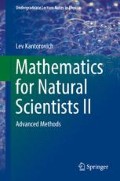Abstract
In Chap. 5 we considered the Fourier transform (FT) of a function f(x) defined on the whole real axis −∞ < x < ∞. Recall that for the FT to exist, the function f(x) must tend to zero at x → ±∞ to ensure the convergence of the integral \(\int _{-\infty }^{\infty }\left \vert f(x)\right \vert dx\). However, sometimes it is useful to study functions f(x) defined only for x ≥ 0 which may also increase indefinitely as x → +∞ (but not faster than an exponential function, see below). For instance, this kind of problems is encountered in physics when dealing with processes in time t when we are interested in the behaviour of some function f(t) at times after some “initial” time (considered as t = 0), at which the system was “prepared” (the initial value problem), e.g. prior to some perturbation acting on it. In such cases another integral transform , named after Laplace, the so-called Laplace transform (LT), has been found very useful in many applications.
Access this chapter
Tax calculation will be finalised at checkout
Purchases are for personal use only
Notes
- 1.
In the following, references to the first volume of this course (L. Kantorovich, Mathematics for natural scientists: fundamentals and basics, Springer, 2015) will be made by appending the Roman number I in front of the reference, e.g. Sect. I.1.8 or Eq. (I.5.18) refer to Sect. 1.8 and Eq. (5.18) of the first volume, respectively.
- 2.
Recall that this means that one-sided limits, not equal to each other, exist on both sides of the discontinuity.
- 3.
Since f(t) is piecewise continuous, so is g a (t), and hence the other Dirichlet condition is also satisfied for the FT to exist.
- 4.
Strictly speaking, this condition is not necessary, but we shall assume it to simplify the proof.
- 5.
This follows from the fact that p λ → 0 on any part of C R in the R → ∞ limit.
- 6.
Note, however, that the two definitions of the convolution in the cases of LT and FT are not identical: the limits are 0 and t in the case of the LT, while when we considered the FT the limits were ±∞, Eq. (5.39).
- 7.
In the latter case the inverse LT of \(G(p) = 1/\left (p - p_{+}\right )^{2}\) can be obtained either directly or by taking the limit p − → p + in g(t) from the first formula in Eq. (6.58) obtained by assuming p + ≠ p −.
- 8.
For a more general discussion, including a derivation of the equations of motion for a multidimensional open classical system (the so-called Generalised Langevin Equation), as well as references to earlier literature, see L. Kantorovich, Phys. Rev. B 78, 094304 (2008).
- 9.
Here we loosely follow (and in a rather simplified form) a detailed discussion which a reader can find in L. Kantorovich, Phys. Rev. B 75, 064305 (2007).
- 10.
The solution to this problem was first obtained by J.E. Sader and S.P. Jarvis in their highly cited paper [Appl. Phys. Lett. 84, 1801 (2004)] using the methods of LT and the so-called fractional calculus. We adopted here some ideas of their method, but did not use the fractional calculus at all relying instead on conventional techniques presented in this chapter.
Author information
Authors and Affiliations
Rights and permissions
Copyright information
© 2016 Springer International Publishing Switzerland
About this chapter
Cite this chapter
Kantorovich, L. (2016). Laplace Transform. In: Mathematics for Natural Scientists II. Undergraduate Lecture Notes in Physics. Springer, Cham. https://doi.org/10.1007/978-3-319-27861-2_6
Download citation
DOI: https://doi.org/10.1007/978-3-319-27861-2_6
Published:
Publisher Name: Springer, Cham
Print ISBN: 978-3-319-27859-9
Online ISBN: 978-3-319-27861-2
eBook Packages: Physics and AstronomyPhysics and Astronomy (R0)

